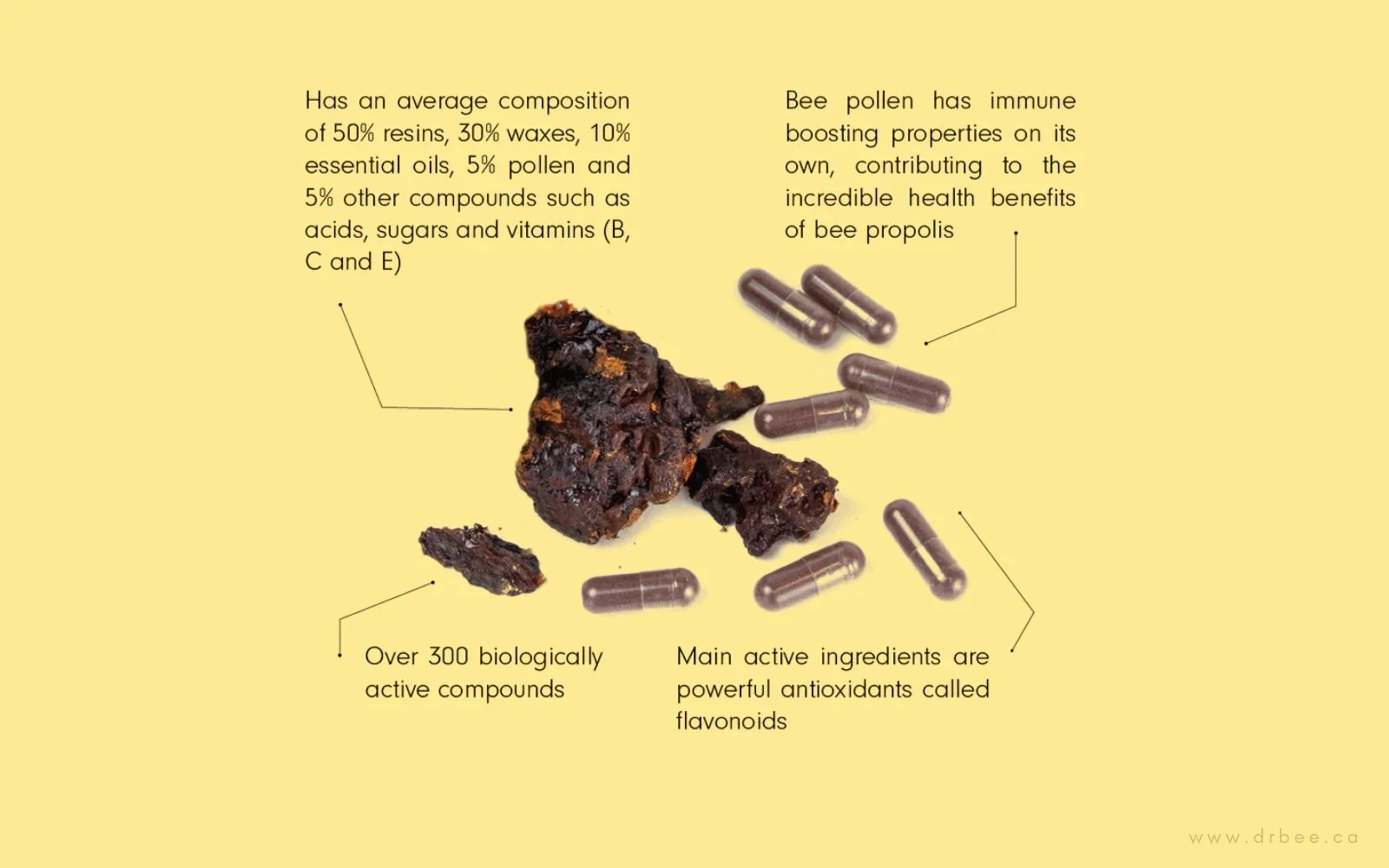Propolis, the new BEST superfood
Bees are one incredible, giving creature. Their simple existence allows for the spreading of pollen which many plants needs to germinate and grow, While collecting pollen to produce their own food source, honey, they can produce many other protective and sterilizing substances that emerging research shows to have more beneficial characteristics than honey alone. They are
propolis
royal jelly
What is Propolis Exactly?
From PubMed - “Propolis is a natural resinous mixture produced by honeybees from substances collected from parts of plants, buds, and exudates. The word propolis is derived from Greek, in which ‘pro’ stands for “at the entrance to” and ‘polis’ for “community” or “city,” which means this natural product is used in hive defense. Due to its waxy nature and mechanical properties, bees use propolis in the construction and repair of their hives—for sealing openings and cracks and smoothing out the internal walls [1, 2] and as a protective barrier against external invaders like snakes, lizards, and so forth, or against wind and rain. Bees gather propolis from different plants in different temperate climatic zones.”
To think of it another way, propolis is like the doormat to the hive. It can seal any cracks and open spaces, offering a structurally sound exterior protecting the hive from rain, heat, cold, wind or whatever. Sticky Propolis protects the hive from pathogens, cleaning bees feet upon entry into the hive and deterring any unwanted microbe or bacteria getting in (to harm the bee babies). If an invader happens to get in, the propolis can safely mummify the intruder allowing for sterile decomposition.
Propolis has proven to have antibacterial, antimicrobial, antiseptic, anti-inflammatory, antifungal, anesthetic, and healing properties have been confirmed. Propolis has been effectively used in treatment of dermatological, laryngological, and gynecological problems, autoimmune disease, neurodegenerative diseases, in wound healing, and in treatment of open wounds, burns and ulcers.
What is Propolis Composed of ?
The main components of propolis are: resin (50%-70%), oil and wax (30%-50%), pollen (5%-10%) and other chemical compounds including: amino acids, minerals, sugars, vitamins B, C and E, flavonoids, phenol, as well as aromatic compounds [4, 5] [1, 8, 9].
Phenolic compounds, esters, flavonoids, terpenes, beta-steroids, aromatic aldehydes, and alcohols are the important organic compounds present in propolis [13].
Proven Benefits:
Immune Function: Propolis potentiates the host defense system and biological immune response modifiers [s].
Gastrointestinal / Antiparasitic : Propolis was shown to inhibit growth and adherence of the trophozoites (a GI tract pathogen) and promoted the detachment of these parasitic organisms [s].
Oncological / Anti-Cancer: propolis and bee pollen successfully protect liver tissue from various forms of regressive liver lesions [s]. Promotes apoptosis on human breast cancer cells and exhibits low or no toxicity towards normal cells due to its selectively toxic properties against tumor cells [s].
Gynecological / Antifungal: The application of 5% aqueous propolis solution resulted in an improvement in vaginal well-being. In addition to providing antibiotic and antimycotic actions, propolis provides early symptomatic relief due to its anesthetic properties [s].
Oral / Antibacterial: mouthwash containing propolis have shown effectiveness in healing surgical wounds [s]. 3% Ethanolic extract of propolis toothpaste gel showed greater potency against gingivitis caused by dental plague in a group of patients [s]. Propolis toothpaste or mouthwash is used for their ability to reduce growth of bacterial plaque and pathogenic microflora that causes gingivitis and periodontitis [s].
Dermatological: Promotive action on collagen synthesis by increasing the collagen content of tissues [s]. Notably decreased free radical activity in healing the wound beds. A clinical study on acne patients using ethanolic extract propolis showed its high efficacy in the treatment of acne vulgaris [s]. Promotes wound closure, especially under conditions such as human diabetic foot ulcer (DFU) [s]. The molecular mechanisms responsible for the wound-healing activity of propolis is Fibronectin (FN). A multifunctional glycoprotein of high molecular weight, which influences the structural stability and functional properties of various organs and tissues (Stoffels, 2013). The fibronectin matrix and its accumulation are essential for cell migration, cell proliferation, cell differentiation, cell adhesion, apoptosis, cellular signaling, angiogenesis, collagen biosynthesis, re-epithelialization, clot formation, and platelet activity - aka EVERYTHING.
Nutrient Dense: Twelve different flavonoids, namely, pinocembrin, acacetin, chrysin, rutin, luteolin, kaempferol, apigenin, myricetin, catechin, naringenin, galangin, and quercetin; two phenolic acids, caffeic acid and cinnamic acid; and one stilbene derivative called resveratrol have been detected in propolis extracts. Propolis also contains important vitamins, such as vitamins B1, B2, B6, C, and E and useful minerals such as magnesium (Mg), calcium (Ca), potassium (K), sodium (Na), copper (Cu), zinc (Zn), manganese (Mn), and iron (Fe). A few enzymes, such as succinic dehydrogenase, glucose-6-phosphatase, adenosine triphosphatase, and acid phosphatase, are also present in propolis [s].
How do Bees make Propolis:
While honey is synthesized from the pollen of flowers, propolis is generated from the other exudates of plants.
Exudate is any fluid that oozes out from a blood vessels or plant as a result of a lesion or inflammation [s]. Plant exudates include saps, resins, gums, and phenolics [s1,s2]. These secretions are carbon-rich materials with repairing properties that are an essential step in the process of wound healing. So you’re getting reparative and restorative ingredients.
For bees, these exudates are gathered from tree buds, sap flows, or other botanical sources [s].
To think of it another way, when you cut into a tree, sap will trickle out. That sap contains the trees immuno(protective) properties.
So when bees are buzzing from tree to plant they are collecting these immuno-properties of the plants, combining it with their saliva and stomach enzymes to make this amber-colored sticky and waxy substance called propolis. Bees have evolved to produce this substance to keep their hives safer for future generations of bee’z to develop. They actually line the inside of the cell walls for newborn baby bees creating a sterile environment for newborns!
Depending on the bee variety and geographical region, the color of propolis can range from ambers, yellows, brown to red and green.
How is this New:
It’s really not. It has been used for thousands of years in eastern medicine as an herbal remedy. Ancient Greeks, Romans, and Egyptians were well aware of the medicinal and healing properties of propolis using it as a germ-fighter for wounds[s]. Though it lost mainstream medicinal use in the middle ages (those tough barbarians) the usages had still been passed down through folk tales and practices. After WWII and with more technological advancements in chromatographic, more scientific study of the chemical composition of propolis continued which allowed for a more complete separation and extraction of Propolis to identify that it contains at least 180 different compounds. For a more complete history of Propolis read this, its quite interesting.
How do I take it? What are the uses?
So now that we know how good this stuff is, how can we consume and benefit from this powerhouse of supergoodness?
Either consume it orally via:
Balms and Creams
Sprays
Or apply it topically
Tinctures and Sprays
Capsules
Powders
Throat Lozenges
Spray it directly on a cut or burn (for soothing, germ-fighting and regenerative properties).
Spray it in your mouth to combat bad breath and cavities.
Spray it in your throat for immune benefits or to combat cold syndrome (upper respiratory tract infections, common cold, and flu-like infections),
Applying a topical cream/balm or serum, for wound healing, treatment of burns, acne scaring, decrease redness, reverse UV-induced skin damage, treat herpes simplex and genitalis, and neurodermatitis.
You can find many cosmetic and skincare brands that contain Propolis for anti-aging, antioxidant and hydrating benefits. It provides a barrier of protection for your skin to keep it intact, antioxidants neutralize the effect of free radicals on your skin, its nourishing and hydrating and speeds up the healing process of wounds, scars and sunburns.
You can find Propolis in mouthwashes and toothpastes to prevent caries and to treat gingivitis and stomatitis
——-
Some brands I found that I think are worthy of looking into
Bee Keepers Naturals - Organic, sustainable beekeeping, third-party pesticide testing to triple check that our hives and our remedies are pesticide-free.
HeyHoney - ethically sources, clean promise. cruelty free
Dr Ceuracle - Natural ingredients, cruelty-free, innovative and clinically/dermatological teststested
Mānuka Health - Non-GMO, Halal Certifications, Driven by deep care for the wellbeing of people, bees and our shared environment. And Each jar/product has a Trust Code - a unique QR code links to that exact jar of honey’s ‘birth certificate’. They are a leader in the way in sustainable beekeeping.
Is there any warning with use?
A word of caution about choosing a propolis supplement. Like all supplements, they are not regulated by the FDA (not that this means anything) but supplies are a dime a dozen. Knowing where you get your supplements from, knowing and having trust in a brand is super is vital to ensure complete efficacy and purity of your bee superfood. You don’t want to be purchasing any joe s’mo bee juice. I found one powder, “bulk supplements” that obviously is a middle man for a larger distributor… there is no information about the propolis besides that is what was in the bag. Was it ethically sourced? was it organic (cuz you don’t want pesticide residues on something you are trying to take the prevent cancer, they’ll just cancel each other out).
One thing to look for when choosing propolis is that that certifies the amount of bioactives on the label (flavonoids and caffeates are the important ones).
Also, while the case goes when we apply things to our skin surface, there is a risk of developing an allergic reaction or contact dermatitis to propolis. In addition, when consumed orally many people that have allergic reactions to bee’s and honey will likly have a similar reaction to propolis.
How to get more information? What inspired me to write this post was after I listened to this really enlightening podcast with Carly Stein Kremer, founder of Beekeeper’s Naturals, a wellness company that is dedicated to bringing effective, natural, and sustainable remedies to the general public.
If you’d like $10 off you’re order at Bee Keepers Naturals use this link




